Day 3
Bogota to Medellin is a one hour flight and we were at the hotel by 11:15am, checked in, freshened up and were ready to get a feel of Medellín.
Unlike other large South American cities where the old town area typically has the majority of sights, many of Medellin’s main attractions are quite spread out. This coupled with significant traffic means that it takes time to see and do things, so one has to plan accordingly. Our hotel was close to Calle 10 which is the Main Street in El Poblado neighborhood. We wandered the streets here which apparently is always a busy and happening area. Roads leading off Calle 10, like Carrera 35, Carrera 37 etc. were all pedestrian-only and had many restaurants and shops. We had a wonderful lunch at a vegan restaurant on Carrera 35.

Later in the afternoon we went up to our hotel dining area for coffee and snacks. The view from our hotel dining area of the city was awesome. The colorful building in the front happened to be hotel Selina and we found out that there were a whole bunch of restaurants around that hotel.

We walked around hotel Selina looking for a restaurant to have dinner and found a great Italian restaurant Romero that had some tasty vegetarian options.

Day 4
We had booked a Viator guided tour and our activities included the following
- Coffee Farm in Peñol
- El Penol Rock in Guatape
Our tour guide came promptly to pick us up from our hotel at 7:30 am. The town of Guatapé is about 2 hours from Medellin and has a colonial feel. We first stopped at a Coffee farm on the outskirts of the small town of Peñol, one hour from Medellín. It was a family farm dedicated to the cultivation of the best export-type coffee. We experienced first-hand, the entire process from coffee cultivation to enjoying the drink.



The roasted seeds are ready to be packed and exported. We had a cup of freshly brewed coffee from the farm which was excellent and also a tea made from the husk of the coffee beans which to our surprise tasted more like to tea and very little flavor of coffee.
Our next stop was the El Peñón de Guatapé, the monolithic rock formation that soars 200 meters above the surrounding landscape. We climbed the 750 concrete steps to the top, and were rewarded with a 360-degree view of the Guatapé Reservoir, a manmade lake that has numerous tentacles lined with vacation homes and hotels.
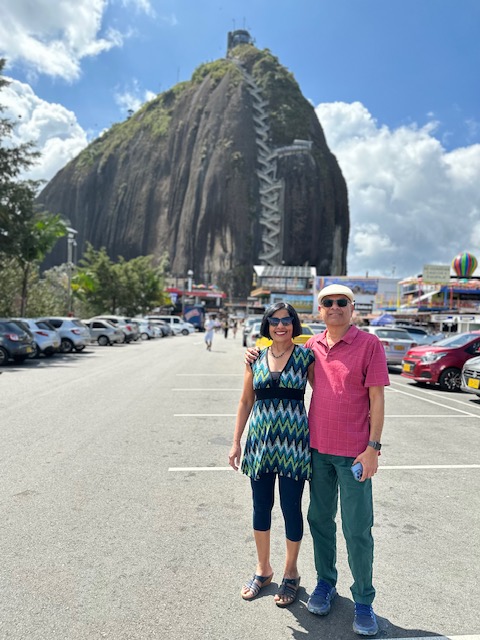
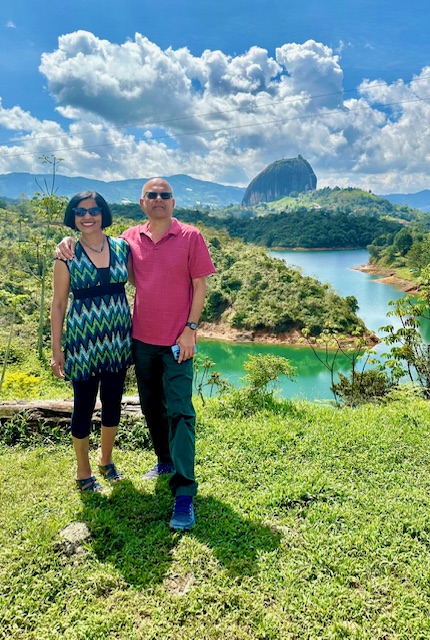
The viewing platform up top has plenty of drink vendors and shaded tables to cool off before huffing it back down to the bottom.
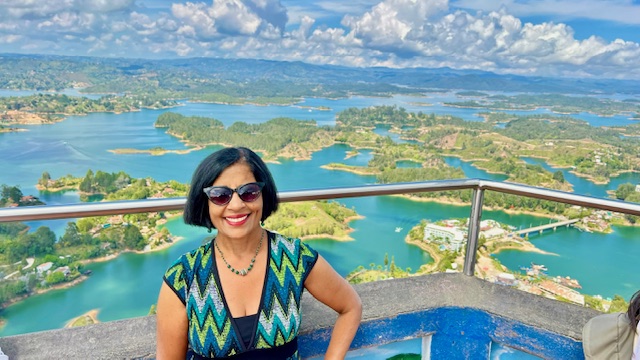


The whole activity of climbing up the rock + spending time at the top + coming down took us about 90 minutes.
Our tour guide then drove us to the colorful town of Guatape. We walked down the cobbled streets stopping to taste some fruits which were pretty much same as the ones we tasted in Bogota. On the way to having lunch at a vegan restaurant, we enjoyed the walk down the cobbled streets with colorful hanging umbrellas, painted vehicles, and shops.





After lunch at the vegan restaurant, we walked to the main square and visited the Our Lady of Carmen Church. Down the street from the main plaza is the Guatape lake where you can take boat rides.


We came back to our hotel in Medellin after 4pm. We had dinner at a restaurant called ‘Naan’ thinking we’d get some authentic Indian food but were a little disappointed. The chickpea dish we ordered was sweet and did not have any Indian spice.
Day 5
We had planned another private guided tour for today to visit the following sites :
- Pueblito Paisa
- Escaleras Electricas De La Comuna 13
- Medellin’s Cable car
- Plaza Botero
- Centro Administrative La Alpujarra
Our tour guide, Jessica, picked us up at 9am from our hotel and our first stop was at Pueblito Paisa. This mock town atop Cerro Nutibara is an open air, living museum, where one can experience life in rural Antioquia at the beginning of the century. A traditional town square is surrounded by a church, mayor’s office, barbershop, and one-room schoolhouse. Many of the materials to build this mock town came from Guatape.

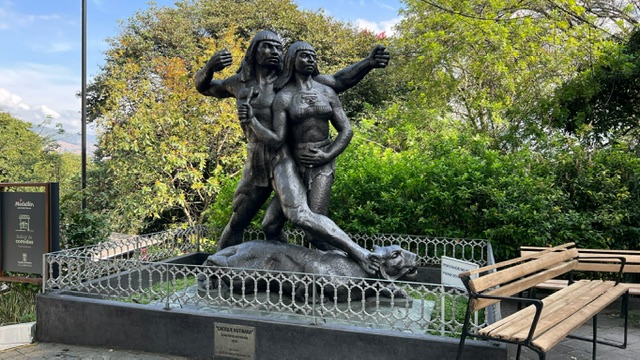
Its setting at the top of a hill, makes it a perfect place to get a great view of the city below. There are souvenir and handicraft shops as well as restaurants that sell Colombian food.

Our next stop was at Escaleras Electricas De La Comuna 13. Medellin is divided into 16 Comunas or municipalities. The hotel we stayed in for example was in Comuna 14, Downtown Medellin is part of Comuna 10. Comuna 13 though, is the most visited and famous of all Comunas, with tour groups wandering through its graffiti-filled streets. This is because, Comuna 13 was once the most dangerous neighborhood in Medellin. An ever-growing system of open-air escalators linking together Comuna 13’s cliff-clinging communities has helped drive down crime and elevate community pride. Many of the escalator care-takers are also street artists who’ve livened up the edges of the escalator route with colorful murals that both reflect the neighborhood’s tough past and offer hope for a promising future.
We were dropped off by the driver at the very top of Comuna 13. Our guide took us on a walking tour explaining the history of this place and how things changed for the better after 2010.
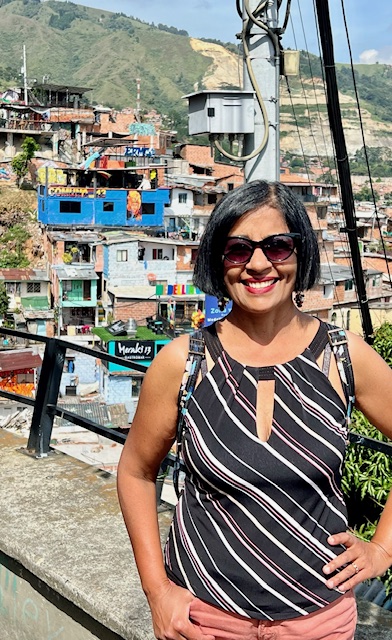


We tried some street food.



Medellin Metrocable – Medellin’s Metrocable system was implemented by its City Council with the purpose of providing a transportation service that complements their metro train. It was designed to reach some of the city’s informal settlements on the steep hills that mark its topography. It is largely considered to be the first urban cable propelled transit system in South America and has been in service since 2004. These futuristic cable cars soar above the city into the surrounding hills, offering a panoramic view of the entire neighborhood.

Medellin has 6 cable car lines. We hopped onto Line J which was close to Comuna 13 and went all the way to the final station at La Aurora and came back all the way to the start of Line J. The view from the cable car of the valley below and the surrounding hills was epic.


The Cable car station also has a metro train station on the ground floor and the ticket you buy holds good for both the cable car and the metro as long as you don’t leave the station. We got off the cable car and took the metro to Medellin downtown.
We got off at Parque Berrio metro station. The whole place was jam packed with people doing Christmas shopping. We walked around the plaza and checked out the Basilica of Our Lady of Candelaria or simply La Candelaria Church. It is famous for being the oldest church in the city.



We then walked among the maze of people to Plaza Botero. Medellin’s famous artist and sculptor Fernando Botero, donated 23 of his large sculptures to the city of Medellin, which you’ll find sprinkled around the Plaza. You have a mix of sculptures of animals, women, and soldiers.
It was hot and crowded in the plaza and there were people posing in front of every sculpture which made it very hard to get a picture of any of them without people. We managed to get a few without people.



As you enter Plaza Botero, you will be drawn by the checkerboard patterned Palacio of Culture Rafael Uribe Uribe. This building, built in the Gothic Revival style first started in 1925, was abandoned for many years and was finally finished in 1982. The building is open to the public free of charge. It also has an impressive dome.


We then walked southwest of Botero onto pedestrian-only Calle 52, which was jammed with people and shops selling just about anything. if we did not have a guide, we’d been totally lost here. One of the buildings you’ll come across is the spectacular National Palace Mall. This building has been restored to its former glory complete with massive chandeliers and skylights. We found many shops selling all kinds of shoes.
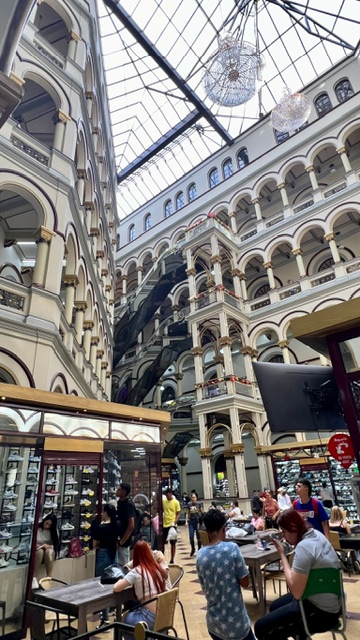


We then left the crowded area and walked on to Plaza Cisneros which was quieter with hardly anyone. We sat down in one of the benches to cool down and get back our breath. Plaza Cisneros was another section of Medellin that was once full of drugs and violence but is now relatively safe. During the night this plaza comes alive with the 300 light poles which look like giant Jedi lightsabers.


Our final stop was Centro Administrative La Alpujarra. Officially known as the José María Córdova Administrative Center which is an urban complex of government buildings built in the 1980s for the administration of the Antioquia department and Medellín municipality. The buildings in the complex include the town hall, the main government offices, the national tax administration and the city courthouse. The plaza also has the sculpture called Monumento a la Raza by Rodrigo Arenas Betancourt, in honor of the history of Antioquia.



We then walked over to the historic Antioquia train station which is located right next to the administrative buildings. Declared a national monument in 1996 for its historical value to the city and the country, Antioquia Station is an emblem of the importance of the railroad in Colombia’s history. This place is maintained by the Antioquia Railway Foundation, a private, non -profit organization established in 1986.


Day 6
We visited Parque Arvi and El Castillo Museo y Jardines on our own today using Medellin’s fantastic metro system. We took an Uber from our hotel to Santo Domingo metro station. From here we took metro line L to the Parque which was a 20 minute ride with stunning view of the city and the forest.
Parque Arvi is a nature preserve covering more than 39.5 acres and is located at an altitude of 2,600 meters. Once you reach there, you can hike a nature trail for which you have to pay about $12/person as a foreigner which was a bit much, but we did it anyway. It was a beautiful hike though, about a mile in length and moderate level with ups and downs. There were food stands and craft Booths at the entrance to the Parque on the day we were there. There are also a couple of small restaurants. We spent a total of 90 minutes in this place. A short way into our hike, a local park dog decided to lead the way for us. It would run ahead and wait for us to catch up…


We took the cable car back to Santo Domingo and then got on to the metro train from the same station going to Aguacatala. From here we took an Uber to the castle which was a 5 minute ride.
El Castillo Museo y Jardines – Once a private residence, today the castle and grounds are an attraction open to everyone for a modest admission fee. We visited just the gardens in this place which was $4/person.


You can totally skip both these attractions if you are short on time. The only thing worthwhile in Park Arvi for the amount spent was the cable ride to this place. As for El Castillo Museo, there are way better castles and gardens in Europe.
Medellin should be in everyone’s list of cities to visit if in Colombia. My opinion is that 3 days here is enough to visit all the main attractions in and around Medellin. If you have more time, its is worth spending a night in Guatape. There are some camping tours offered on viator on the lake.